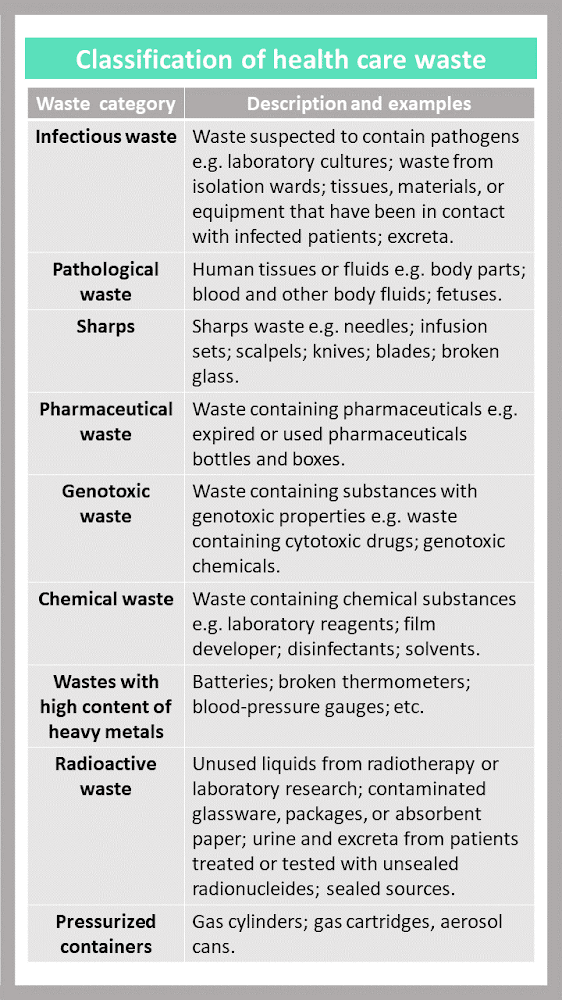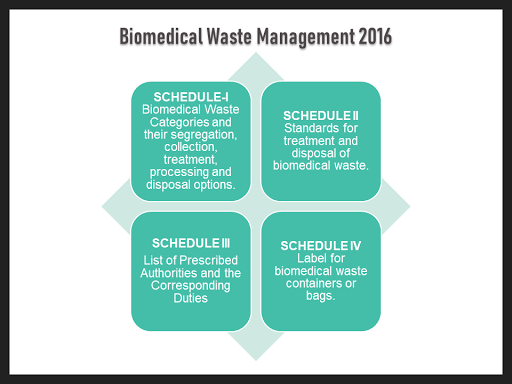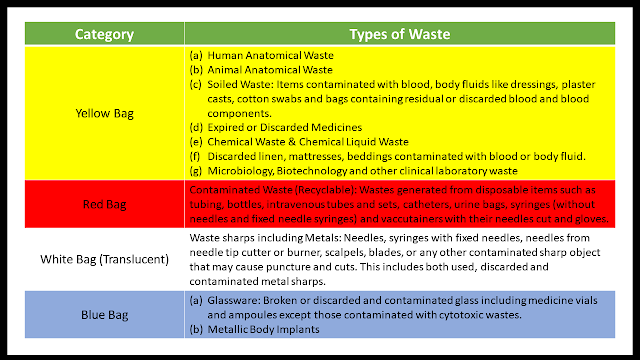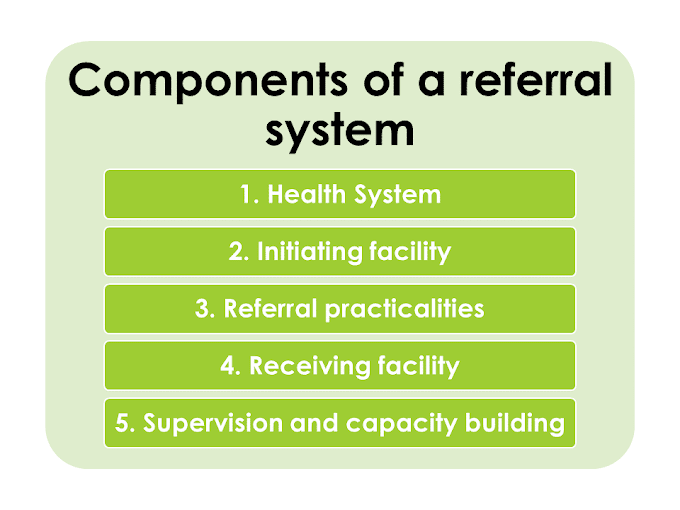 |
| Biomedical waste |
The waste produced in the course of health care activities carries a higher potential for infection and injury than any other type of waste. Therefore, it is essential to have safe and reliable method for its handling. Appropriate management of health care waste is thus a crucial component of environmental health protection, and it should become an integral feature of health care services.
Definition of Biomedical Waste
Biomedical waste means any waste, which is generated during the diagnosis, treatment or immunization of human-beings or animals, or in research activities pertaining thereto or in the production or testing of biologicals. (According to Biomedical waste Rules, 1998 of India)
- Between 75 to 90 per cent of the waste produced by the health care providers is non-risk or general health care waste, comparable to domestic waste.
- The remaining 10 to 25 per cent health care waste is regarded as hazardous and may create a variety of health risk.
Sources of Health Care Waste
- Government and Private hospitals
- Nursing homes
- Physician's office/clinics
- Dentist's office/clinics
- Primary health centres
- Dispensaries
- Vaccination centres
- Research organizations
- Laboratories
- Animal houses
- Mortuaries
- Medical research and training establishments
- Blood banks and collection centres
- Slaughter houses
- Bio-technology institutions/production unit
Classification/Types of Health Care Waste
 |
| Types of Biomedical Waste |
Health Hazards of Biomedical Waste
- Pathogens in infectious waste may enter the human body through a puncture, abrasion or cut in the skin, through mucus membranes by inhalation or by ingestions. For e.g. HIV and Hepatitis virus B and C.
- Hazardous chemicals and pharmaceutical waste are toxic, genotoxic, corrosive, flammable, reactive, explosive or shock-sensitive.
- Genotoxic and radio-active waste causes genotoxicity and affect the genetic material.
Treatment and disposal technologies for health care waste
- Incineration
- Chemical disinfection
- Wet and dry thermal treatment
- Microwave irradiation
- Land disposal
- Inertization
1. Incineration
Incineration is a high temperature dry oxidation process, that reduces organic and combustible waste to inorganic incombustible matter and results in a very significant reduction of waste-volume and weight. The process is usually selected to treat wastes that cannot be recycled, reused or disposed off in a land fill site.
Characteristics of the waste suitable for incineration:
- Low heating volume - above 2000 kcal/kg for single-chamber incinerators, and above 3500 kcal/kg for pryolytic double chamber incinerators.
- Content of combustible matter above 60%.
- Content of non-combustible solids below 5%.
- Content of non-combustible fines below 20%.
- Moisture content below 30%.
Waste types not to be incinerated:
- Pressured gas containers.
- Large amount of reactive chemical wastes.
- Silver salts and photographic or radiographic wastes.
- Waste with high mercury or cadmium content, such as broken thermometers, used batteries and lead-lined wooden panels.
- Sealed ampules or ampules containing heavy metals.
- Halogenated plastics such as PVC.
Types of Incinerators:
- Double-chamber pyrolytic incinerator: It may be especially designed to burn infectious health care waste.
- Single-chamber furnaces with static grate: It should be used only when pyrolytic incinerators are not affordable.
- Rotary kilns: It is operating at high temperatures, capable of causing decomposition of genotoxic substances and heat-resistance chemicals.
2. Chemical Disinfection
Chemicals are added to waste to kill or inactivate the pathogens it contains, this treatment usually results in disinfection rather than sterilization. Chemical disinfection is most suitable for treating liquid waste such as blood, urine, stools, or hospital sewage.
3. Wet and Dry Thermal Treatment
- Wet Thermal Treatment: Wet thermal treatment or steam disinfection is based on exposure of shredded infectious waste to high temperature, high pressure steam, and is similar to the autoclave sterilization process. The process is inappropriate for the treatment of anatomical waste and animal carcassess, and will not effectively treat chemical and pharmaceutical waste.
- Screw-feed Technology: It is the basis of non-burn, dry thermal disinfection process in which waste is shredded and heated in a rotating auger. The waste is reduced by 80% in volume and by 20-35% in weight. This process is suitable for treating infectious waste and sharps, but it should not be used to process pathological cytotoxic or radio-active waste.
4. Microwave Irradiation
Most microorganisms are destroyed by the action of microwave of a frequency of about 2450 MHz and a wave length of 12.24 nm.
5. Land Disposal
There are two types of disposal land-open dumps and sanitary landfills. Health care waste should not be deposited on or around open dumps.
6. Inertization
The process of Inertization involves mixing waste with cement and other substances before disposal, in order to minimize the risk of toxic substances contained in the wastes migrating into the surface water or ground water.
A typical proportion of the mixture is: 65% pharmaceutical waste, 15% lime, 15% cement and 5% water. A homogenous mass is formed and cubes or pellets are produced on site and then transported to suitable storage sites.
Biomedical Waste Management in India
Biomedical waste Rule 1998, prescribed by the Ministry of Environment and Forests, Government of India, came into force on 28th July, 1998. This rule applies to those who generate, collect, receive, store, dispose, treat or handle biomedical waste in any manner.
The biomedical waste 1998 rules were modified in the following years-2000, 2003, and 2011. Now Ministry of Environment, Forest and Climate change in March 2016 have amended the Biomedical Waste Management Rules. These new rules have increased the coverage, simplified the categorization and authorization while improving the segregation, transportation and disposal methods to decrease environmental pollution.
It has four schedule, five forms and eighteen rules.
Eighteen rules of Biomedical Waste Management 2016
- Short title commencement
- Application
- Definitions
- Duties of the Occupier
- Duties of the operator of a common bio-medical waste treatment and disposal facility
- Duties of authorities
- Treatment and disposal
- Segregation, packaging, transportation and storage
- Prescribed authority
- Procedure for authorisation
- Advisory Committee
- Monitoring of implementation of the rules in health care facilities
- Annual report
- Maintenance of records
- Accident reporting
- Appeal
- Site for common biomedical waste treatment and disposal facility
- Liability of the occupier, operator of a facility
Four schedule of Biomedical Waste Management 2016
Labels for Biomedical Waste Containers or Bags
Forms used in Biomedical Waste Management According to 2016 Rule
- Form-I: Accident reporting
- Form-II: Application for Authorisation or Renewal of Authorisation
- Form-III: Authorisation
- Form-IV: Annual Report
- Form-V: Application for filling appeal against order passed by the prescribed authority
Color coding and type of container for disposal of biomedical wastes
Amendments in Biomedical waste Management Rule 2016
Generators of biomedical waste will not use chlorinated plastic bags and gloves beyond March 27, 2019 in medical applications to save the environment. Blood bags have been exempted for phase-out, as per the amended Biomedical Waste Rule, 2018.







0 Comments